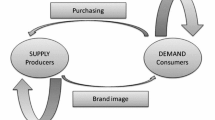Abstract
A simple Monte-Carlo model is used to demonstrate that the statistical problems typical for aggregate consumption, such as autocorrelation and noncointegration, can be generated through a change in income distribution if individual consumers are sufficiently heterogeneous in their marginal propensity to consume. The results are obtained for individual consumers who are assumed to be completely myopic. The dynamics at the aggregate level can, therefore, be attributed only to the aggregation process, not to dynamic optimization of individual consumers or to adjustment costs and lags on the part of a representative agent.
Similar content being viewed by others
References
Ball, R. J.; Drake, P. S. "The Relationship between Aggregate Consumption and Wealth,"International Economic Review, 5, 1, January 1964, pp. 63–81.
Blundell, Richard. "Consumer Behaviour: Theory and Empirical Evidence — A Survey,"Economic Journal, 98, 369, March 1988, pp. 16–65.
Borooah, Vani K.; Sharpe, Don R. "Aggregate Consumption and the Distribution of Income in the United Kingdom: An Econometric Analysis,"Economic Journal, 96, 382, June 1986, pp. 449–66.
Davidson, James E. H.; Hendry, David F.; Srba, Frank; Yeo, Stephen J. "Econometric Modelling of the Aggregate Time-Series Relationship between Consumers' Expenditure and Income in the United Kingdom,"Economic Journal, 88, 352, December 1978, pp. 661–92.
Deaton, Angus.Understanding Consumption. Oxford, England: Clarendon Press, 1992.
Duesenberry, James S.Income, Saving and the Theory of Consumer Behavior. Cambridge, MA: Harvard University Press, 1949.
Engle, Robert F.; Granger, Clive W. J. "Co-integration and Error Correction: Representation, Estimation, and Testing,"Econometrica, 55, 2, March 1987, pp. 251–76.
Fair, Ray C.; Dominguez, Kathryn M. "Effects of the Changing U.S. Age Distribution on Macroeconomic Equations,"American Economic Review, 81, 5, December 1991, pp. 1276–94.
Friedman, Milton.A Theory of the Consumption Function, Princeton, NJ: Princeton University Press, 1957.
Grandmont, Jean Michel. "Transformations of the Commodity Space, Behavioural Heterogeneity, and the Aggregation Problem,"Journal of Economic Theory, 57, 1, June 1992, pp. 1–35.
Hadjimatheou, George.Consumer Economics After Keynes: Theory and Evidence of the Consumption Function. New York, NY: St. Martin's Press, 1987.
Hall, Robert E. "Stochastic Implications of the Life Cycle- Permanent Income Hypothesis: Theory and Evidence,"Journal of Political Economy, 86, 6, December 1978, pp. 971–87.
Kuznets, Simon.Uses of National Income in Peace and War, Occasional Paper 6, New York, NY: National Bureau of Economic Research, 1942.
__.National Product Since 1869, New York, NY: National Bureau of Economic Research, 1946.
Lucas, Robert E., Jr. "Econometric Policy Evaluation: A Critique,"Journal of Monetary Economics, 1, supplementary series, 1976, pp. 19–46.
Modigliani, Franco; Brumberg, Richard. "Utility Analysis and the Consumption Function: An Interpretation of Cross-Section Data," in Kenneth K. Kurihara, ed.,Post-Keynesian Economics, New Brunswick, NJ: Rutgers University Press, 1954, pp. 388–436.
Modigliani, Franco. "Life Cycle, Individual Thrift, and the Wealth of Nations,"American Economic Review, 76, 3, June 1986, pp. 297–313.
Shafer, Wayne J.; Sonnenschein, Hugo. "Market Demand and Excess Demand Functions," in Kenneth J. Arrow; Michael D. Intriligator, eds.,Handbook of Mathematical Economics, Vol. II, New York, NY: North-Holland, 1982.
Sonnenschein, Hugo. "Market Excess Demand Functions,"Econometrica, 40, 3, May 1972, pp. 549–63.
Spanos, Aris. "Early Empirical Findings on the Consumption Function, Stylized Facts or Fiction: A Retrospective View,"Oxford Economic Papers, 41, 1, January 1989, pp. 150–69.
Stoker, Thomas M. "Empirical Approaches to the Problem of Aggregation over Individuals,"Journal of Economic Literature, 31, 4, December 1993, pp. 1827–74.
Summers, Lawrence H. "The Scientific Illusion in Empirical Macroeconomics,"Scandinavian Journal of Economics, 93, 2, June 1991, pp. 129–48.
Thomas, J. J. "The Early Econometric History of the Consumption Function,"Oxford Economic Papers, 41, 1, January 1989, pp. 131–49.
__. "Income Distribution and the Estimation of the Consumption Function: A Historical Analysis of the Early Arguments,"History of Political Economy, 24, 1, Spring 1992, pp. 153–81.
Author information
Authors and Affiliations
Rights and permissions
About this article
Cite this article
Zietz, J. Aggregate consumption with heterogeneous agents and a changing income distribution. Atlantic Economic Journal 24, 361–370 (1996). https://doi.org/10.1007/BF02298437
Issue Date:
DOI: https://doi.org/10.1007/BF02298437




